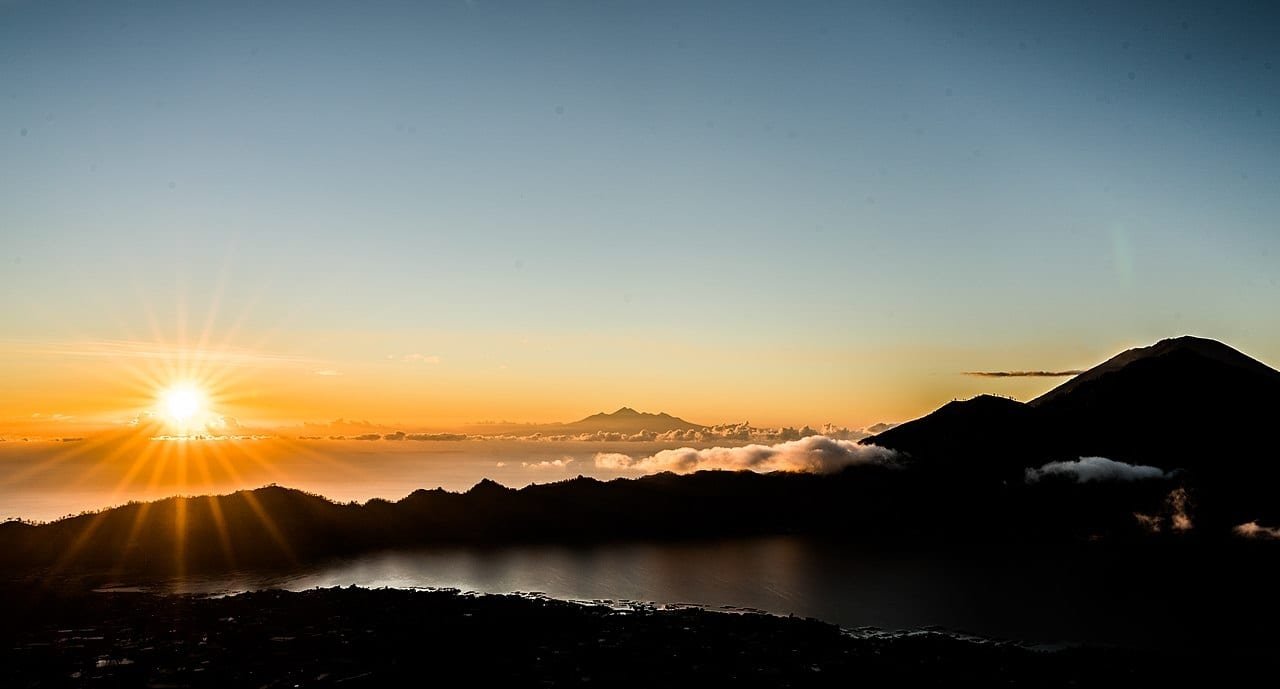CLIMBING MOUNT BATUR IN BALI: HIKE AT SUNRISE!
Mount Batur, try the sunrise hike during your stay in Bali, one of the well-known hikes is the ascent of Mount Batur in the early morning. By early morning we mean before sunrise… Indeed the principle of the excursion is to witness this sunrise from the top of the volcano!
No need to say much more than what we see in the photos… The landscape offered is a sea of clouds, the Agung volcano, and the sun peeking out from the horizon. It is simply beautiful, and definitely one of the highlights of my stay in Bali.
In this article, we come back to this ascent of Mount Batur, sharing our feedback. And by indicating how to do the same thing, by yourselves, or accompanied by a guide as we were able to do.
Access to the start of the Mount Batur hike
Where is Mount Batur?
Mount Batur is located in the east of the island of Bali, so if you are not staying nearby, access to the start of the hike around 4 a.m. is not really trivial…
We share in this article my experience of hiking in an all-inclusive package (this one, with a driver who brings you to the site from his accommodation, hike accompanied by a guide, and return to his accommodation).
But if you want to do the hike by yourself in the early morning, the ideal is clearly to stay close to the starting point of the hike. This is to minimize travel time as much as possible in the middle of the night, barely awake, and on the small Balinese roads…
For this there are in particular these villas not far from the starting point, or the Batur Green Hill hotel.
In any case, whether you go there via the transport of a driver, or whether you go to Mount Batur by yourself, the start of the hike is located at the parking lot of the Pura (temple) Jati Batur.
With or without a guide?
For the hike consisting of reaching the summit of Mount Batur in the early morning, we had read during my preparations for a trip to Bali, that when you are not accompanied by an official guide, access from hiking can bring tension to the parking lot. Apparently it is not well seen to hike solo, but personally we did not notice it.
This remark is in any case not valid during the day. Indeed, hiking accompanied by a guide during the day is not very interesting: you can see the path perfectly well.
But beyond the professional guide during the climb, the service also includes transport from your accommodation. Which is clearly appreciable in the middle of the night, and this regardless of where we are staying (in my case, he came to pick us up near Seminyak, a few kilometers north of Denpasar).
In summary, we can say that:
- In the early morning, hiking in the dark and with a night start requires being well prepared. Beyond the fact that it is the most practiced solution, it is also the easy solution to be able to take full advantage of this moment. Without this solution, clearly we would not have done it.
- During the day, the guide is not necessary. On the other hand, the “show” is not the same as in the early morning…
Go through a local agency
To avoid having to worry, we did the simplest thing and went through a local agency (this one), via an online booking site.
Beyond the driver, we benefited from a guide during the hike, which we really appreciated.
Even lit with a headlamp, the ground being volcanic, the supports are not always easy to find. And the experience of someone who knows the way well is a significant plus. Remember that it is 4am, and that we are not yet fully awake…
For the price we had paid around fifty euros per person (for this service, reserved in advance).
Get up early: the constraint to take into account
I do not hide the fact that for this excursion to Mount Batur the awakening is harsh… It varies according to the season, but the sun generally rises around 6am. Add to that the climb to the summit, which takes 2 hours, and the travel time from your hotel or villa.
Depending on your location, this means getting up between 1:30 and 2:30 a.m. approximately! The drivers can indeed pick you up in the south of the island, on the Kuta coast. But also from closer points such as from Ubud or Amed. As an indication, it is still necessary to count an hour’s drive from Ubud.
Climbing Mount Batur
The route, stage, itinerary, route, trajectory,
I rate the Mount Batur hike as medium difficulty. As with any hike that consists of climbing, the difficulty lies above all in finding your rhythm so as not to lose your breath too quickly.
The elevation gain of this hike is 800 meters.
However, Mount Batur is a volcano, and past eruptions have lined some flanks with lava that has hardened and mostly flaked over time.
The hiking path is therefore often filled with black pebbles, more or less large, not very stable, and on which you sometimes have to climb to move forward.
You must therefore be careful where you put your feet and take good support. And let’s not forget that on the way out we walk by the light of the flashlight…
Equipment for hiking Mount Batur
We therefore advise to have a pair of sneakers that catch a minimum. Avoid smooth soles! Note that the guide is still there to help us clear our way, and give us a hand to climb the rocks if necessary.
For the record, on the way down I saw someone doing the descent in sandals! I take my hat off to him, and I think he was lucky not to slip…
For this ascent it takes between 1h30 and 2h depending on your pace. Admittedly, we are in the dark, but the torch allows us to orient ourselves. And above all, we are far from alone… We therefore see a ballet of beams of flashlights in front, and behind. This hike is more or less a victim of its own success and is therefore relatively popular.
For our part the ascent was foggy, and it often is apparently the case. But that is part of the scenery of this hike, because after a while we finish crossing this cloud cover.
We are therefore in the end above the mist, which makes all the beauty of the sunrise!
At the top of Mount Batur
The sunrise
In terms of altitude, Mount Batur is the 2nd highest volcano in Bali: it culminates at 1717 m (5633 ft). It comes after Mount Agung, which rises to 3142 meters (10308 ft).
In the early morning, and at altitude, the temperatures are rather low. So bring a good sweater or jacket for the hike, and especially for the summit where you stop moving.
In addition to the accompaniment, the guides also provide breakfast once you reach the top. Sandwiches, bananas, coffee and boiled eggs that can be cooked in the heat sources of the volcano 😉. There is also a cabin where you can sit and quietly wait for the sunrise.
The crater of the volcano
The ascent of Mount Batur allows you to enjoy the first light of day!
Once the spectacle of the sunrise is over, it is possible to walk around, and in particular to get a little closer to the crater. This shows that this volcano is indeed still active, because we can see several sources of smoke.
The last eruption dates from the year 2000. But the most significant was that of 1917 when several thousand victims were counted. As well as many houses and temples that were wiped off the map.
You then have to return to the car park by doing the reverse. The difficulty is different than during the climb, because it is a question of finding your grips well so as not to slip forward.
Nevertheless, this descent is done well, and it is faster than the ascent, of course. We can then visualize the path traveled on the outward journey and observe the landscape this time.
What equipment for the Mount Batur hike?
If you are like us, and do the hike before sunrise, you must above all take a good sweater. This will be used both for the ascent of Mount Batur and especially for the wait at the summit.
Indeed we arrive all the same well before sunrise in order not to miss it. So the wait can seem long and chilly. For the descent, however, the sun has risen and the weather is better.
I said it above, equip yourself with a pair of shoes that grip the ground. You don’t necessarily need great hiking shoes, just sneakers without a smooth sole.
If you decide to do it by yourself (without a guide), absolutely provide flashlights (and if possible headlamps). In the case of services accompanied by a guide that I mentioned above, these are provided.
Batur region
The road rises and the thermometer slowly drops. From Ubud, fruit and vegetable sellers are increasingly present on the side of the roads, in addition to the usual warungs and stalls. The piles of tropical fruits and jeruk (orange), those very fragrant green-skinned oranges typical of the region, pile up as one approaches the village of Kintamani, in the north of Bali. For a few thousand rupees, you can treat yourself to a basket of fruits in the colors of the rainbow and taste the different local varieties: pineapples, mangosteens, watermelons, bananas…
The Kintamani region is known to be the breadbasket of Bali. No or few rice fields compared to the rest of the island, but a cooler and more humid climate all year round which allows the cultivation of citrus fruits, but also tomatoes, eggplants, coffee or shallots. Depending on the route taken, you will sometimes have to pay an obol of a few tens of thousands of rupees to access the village of Kintamani. Past a few shops and a few restaurants at the entrance to the village, the panorama on the right of the roadway is striking. A grandiose view of the entire caldera is offered to us, with the volcano in the center, and Lake Batur overlooked by Mount Abang. The latter culminates at 2152 meters and is the second highest peak in Bali behind the famous Mount Agung. On the flanks of Gunung Batur, large flows of black basaltic lava testify to past eruptions and have permanently settled in the landscape. A still active volcano whose last eruption dates back to 2000, one can occasionally observe white fumaroles (openings in the earth’s surface that emit steam and volcanic gases, such as sulfur dioxide and carbon dioxide) escaping from its craters – there are three craters at the top of Mount Batur.
In Kintamani, many restaurants offering an extraordinary view of the entire caldera allow you to take a break to eat and drink, before descending to the lake and exploring its surrounding villages.
Sources: Villa Carissa Bali, PinterPandai, CleverlySmart
Photo credit: Aaron Rentfrew via Wikimedia Commons (CC BY-SA 4.0)



